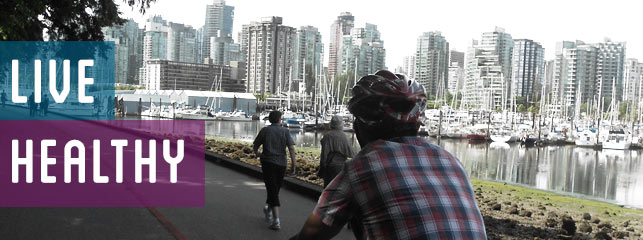
16 Sep A Healthy Life Begins with a Healthy Environment
What’s the cause for the recent rise in urban living? I blame it on Seinfeld. It was the first show to glorify the urban lifestyle. As millions of Americans sat watching TV in their suburban home, Seinfeld depicted a way of life that never crossed the minds of suburbanites.
Ok, so I can’t blame it on Seinfeld, but you have to admit, ever since then there have been an increasing number of shows set in energetic urban environments. It’s hard to turn on the TV and not find a show that fits this description; Sex In The City, How I Met Your Mother, Grey’s Anatomy, CSI New York, Rules of Engagement, and the list goes on. In fact, the Millennial generation is increasingly choosing urban environments over the suburban lifestyle they were raised in, and the proof of this can be found in all the shows now geared precisely to this way of life.
But there’s more to this movement than the glitz and glam portrayed in the movies and TV shows. There are more practical reasons for the urban trend and can be split up into three categories: health, economic and environmental. I want to discuss all of them, but it’s a lot to discuss so I’m going to have to split this blog into three parts beginning with health. Before I start let’s get on the same page about something -urbanism.
What is Urbanism?
Defining urbanism is a key component in understanding the lifestyle that This Could Be PHX strives to promote and that Millennials are increasingly beginning to choose. Here’s a list of its key features:
- Mixed-use buildings and zoning
- Cultural amenities
- Walkability
- Diverse communities
- Multi-family housing
- Parks
- Public transportation; rail, bus, trolley, bike-share
- Parallel parking and parking garages
If you live in a place with all the aforementioned components, then you can say you live in an urban area. If few to none of these components can be found where you live, well, then you may want to continue reading and see what benefits could arise from a change of location.
The Health Benefits
Now let’s get back on task, what are the health benefits of committing to an urban lifestyle? The 70 percent of Americans who currently live in suburbia might be surprised at just how many there are. From decreased risk of being involved in an automobile accident to the improved health that is a result of walking and biking to 90 percent of destinations, the health benefits are just beginning. Fewer rates of obesity, respiratory problems, loneliness, depression, isolation and violence are also included in the benefits of an urban lifestyle. Violence? Yes, even violence can be linked to the suburban lifestyle, a fact that runs contrary to everything suburbanites are taught about cities. So let’s start breaking down the advantages of urbanism and the disadvantages of suburbia. To begin we have to start with the main contributor to sprawl – automobiles.
Automobiles
Automobiles have promoted the ever expanding sprawl that dominates this country and, surprisingly, they are also the cause of many of the health risks American’s now face. First and foremost, for anyone between the ages of 1-34, automobile accidents are the leading cause of death. That’s right! 3.2 million American’s have been killed in automobile accidents. If we are not losing our life in a car accident we can be certain that we have a one-in-three chance that we will someday be seriously injured in one.
So those are some facts for America as a whole, but how do they relate to cities and suburbia? Well, as you may have guessed, the more urban the city, the more walkable, the more alternative transportation choices, the less time we spend in cars and conversely, the less risk we have of being injured or killed in them. The facts speak for themselves. The United States in 2004 experienced 14.5 traffic fatalities per 100,000 population. New York, San Francisco, and Portland (all excellent examples of urban environments) experienced rates of 3.1, 2.5 and 3.2 deaths per 100,000 population respectively. Those rates are on par or better than many European cities.
As Jeff Speck notes in his book Walkable City: How Downtown Can Save America, One Step At A Time, [quote]It is the places shaped by automobiles that seem most effective at smashing them into each other.[/quote] All this talk about car accidents and death says nothing about the frustration and time lost due to the increasing commute times that accompany the suburban lifestyle. [quote]A Department of Housing and Urban Development study estimates that Americans spend over two hours each day in their cars… and lose on average the equivalent of 31 days to commuting each year.[/quote]
Obesity
Another health risk associated with suburbia and automobiles but alleviated by urbanism is obesity. The facts about obesity are astonishing:
- In 1970, one-in-ten American’s were obese.
- In 2007, one-in-three American’s were obese.
- In 1991, no states had obesity rates over 20%
- In 2007, forty-nine states had obesity rates over 20%
Wow!! But can we contribute all this to sprawl? According to the studies – yes. Cities that cater to the pedestrian rather than the car all see lower obesity rates than their suburban neighbors. That means less risk of:
- Coronary disease
- Diabetes
- Hypertension
- Colorectal Cancer
- Endometrial Cancer
- Gallstones
- Osteoarthritis
Isolation / Loneliness
Beyond the health risks mentioned above, there are even more effects attributed to the isolating environment 70% of American’s live in. And here is where the social interactions and genuine communities found in urban environments can come to the rescue. According to Douglas E. Morris in his book It’s a Sprawl World After All, Americans are increasingly becoming more isolated, and isolation leads to depression, low self-esteem, incivility and even violence.
Children, teenagers and the elderly are the prime targets of isolation. Suicide is the third greatest killer of teenagers between the age of 15-19 and 10% of children from 12-16 have reported to be lonely. But in urban environments, these groups of people have access to public transportation, diverse communities, arts and culture and much more. They are not reliant on their parents or a vehicle to experience life. Children and teenagers can learn responsibility and the value of money when a parent asks them to pick up groceries from the corner market as they walk home from school.
The elderly, especially those who can no longer drive, feel like a part of the community. They have full access to all aspects of that community. And most of all, they don’t have to be shipped off to a retirement home where they are forced to live in an alienating ‘community’ that keeps them separated from the rest of the world.
Another Perspective
Humans are social animals and communal interactions are the key to our existence. Urban environments naturally create communities while sprawl makes connection more difficult. How many parents today have complained about their children constantly being glued to the TV or video games? Without a genuine community people are forced to build relationships however they can. Unfortunately, suburbia has driven people to fulfill that need through TV or other distractions.
To sum up an all too brief blog on the health benefits of urban living versus the risks of suburban living; a healthy life can be attributed to a healthy environment. At first glance we might not recognize that urban environments can be healthier than suburban ones, but the research in support of it is out there for anyone willing to seek it out.
Resources
Interested in reading the resources I’ve cited here? These are two great books with valuable insight into urbanism:
It’s a Sprawl World After All, Douglas E. Morris, pages 50-51, & 61
Walkable City: How Downtown Can Save America, One Step At A Time, Jeff Speck, pages 40, & 44-45[/box]




Sorry, the comment form is closed at this time.